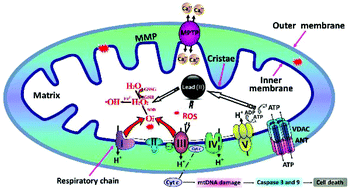当前位置:
X-MOL 学术
›
Toxicol. Res.
›
论文详情
Our official English website, www.x-mol.net, welcomes your
feedback! (Note: you will need to create a separate account there.)
Toxicity of Pb2+ on rat liver mitochondria induced by oxidative stress and mitochondrial permeability transition
Toxicology Research ( IF 2.2 ) Pub Date : 2017-09-25 00:00:00 , DOI: 10.1039/c7tx00204a Long Ma 1, 2, 3, 4, 5 , Jun-Yi Liu 6, 7, 8 , Jia-Xin Dong 5, 9, 10, 11, 12 , Qi Xiao 5, 13, 14, 15 , Jie Zhao 1, 2, 3, 4, 5 , Feng-Lei Jiang 1, 2, 3, 4, 5
Toxicology Research ( IF 2.2 ) Pub Date : 2017-09-25 00:00:00 , DOI: 10.1039/c7tx00204a Long Ma 1, 2, 3, 4, 5 , Jun-Yi Liu 6, 7, 8 , Jia-Xin Dong 5, 9, 10, 11, 12 , Qi Xiao 5, 13, 14, 15 , Jie Zhao 1, 2, 3, 4, 5 , Feng-Lei Jiang 1, 2, 3, 4, 5
Affiliation

|
Pb2+ exposure in humans occurs mainly through air inhalation, food and water uptake which has been shown to be generally associated with numerous body functions such as the central and peripheral nervous systems, the red blood cells, the kidneys and the liver. It has been reported that the liver is the storage site and an important primary target in Pb2+ toxicity, and the hepatotoxicity of Pb2+ could be resulted from the impairment of the liver mitochondria. In this study, several mitochondrial dysfunctions following the addition of Pb2+ (10–160 μM) were investigated. We found that Pb2+ inhibited the enzyme activities of mitochondrial respiratory complexes and complex III was the major source of Pb2+-induced significant reactive oxygen species (ROS) formation. As a consequence, our results showed that Pb2+ induced significant progress in mitochondrial lipid peroxidation, adenosine triphosphate (ATP) consumption and glutathione (GSH) oxidation. On the other hand, Pb2+ induced marked changes in mitochondrial permeability transition (MPT) accompanied by mitochondrial swelling, mitochondrial membrane potential collapse, mitochondrial membrane fluidity decrease and cytochrome c (Cyt c) release. Additionally, several mitochondrial MPT inhibitors and chelators were utilized to determine the possible interaction sites of Pb2+ on mitochondria. In general, our data supported that the Pb2+-induced liver toxicity was a result of the disruptive effect on the mitochondrial respiratory complexes. This disruptive effect caused oxidative stress and MPT, which led to mitochondrial dysfunctions and even cell death signalling via mitochondrial permeability transition pore (MPTP) opening and Cyt c release.
中文翻译:

氧化应激和线粒体通透性转变诱导的Pb 2+对大鼠肝线粒体的毒性
人体中Pb 2+的暴露主要是通过空气吸入,食物和水摄入而发生的,这已被证明通常与许多身体功能有关,例如中枢和周围神经系统,红细胞,肾脏和肝脏。据报道,肝脏是储存场地和铅的重要首要目标2+毒性,和铅的肝毒性2+可从肝线粒体的减值所致。在这项研究中,研究了添加Pb 2+(10–160μM)后的几种线粒体功能障碍。我们发现Pb 2+抑制线粒体呼吸复合物的酶活性,而复合物III是Pb的主要来源2+诱导显着的活性氧(ROS)形成。结果,我们的结果表明,Pb 2+在线粒体脂质过氧化,三磷酸腺苷(ATP)消耗和谷胱甘肽(GSH)氧化方面诱导了重大进展。另一方面,Pb 2+引起线粒体通透性转变(MPT)的显着变化,伴随着线粒体肿胀,线粒体膜电位塌陷,线粒体膜流动性降低和细胞色素c(Cyt c)释放。另外,利用几种线粒体MPT抑制剂和螯合剂来确定线粒体上Pb 2+的可能相互作用位点。总的来说,我们的数据支持铅2+诱导的肝毒性是对线粒体呼吸复合物的破坏作用的结果。这种破坏性作用导致氧化应激和MPT,从而导致线粒体功能障碍,甚至通过线粒体通透性转换孔(MPTP)打开和Cyt c释放而导致细胞死亡。
更新日期:2017-10-30
中文翻译:

氧化应激和线粒体通透性转变诱导的Pb 2+对大鼠肝线粒体的毒性
人体中Pb 2+的暴露主要是通过空气吸入,食物和水摄入而发生的,这已被证明通常与许多身体功能有关,例如中枢和周围神经系统,红细胞,肾脏和肝脏。据报道,肝脏是储存场地和铅的重要首要目标2+毒性,和铅的肝毒性2+可从肝线粒体的减值所致。在这项研究中,研究了添加Pb 2+(10–160μM)后的几种线粒体功能障碍。我们发现Pb 2+抑制线粒体呼吸复合物的酶活性,而复合物III是Pb的主要来源2+诱导显着的活性氧(ROS)形成。结果,我们的结果表明,Pb 2+在线粒体脂质过氧化,三磷酸腺苷(ATP)消耗和谷胱甘肽(GSH)氧化方面诱导了重大进展。另一方面,Pb 2+引起线粒体通透性转变(MPT)的显着变化,伴随着线粒体肿胀,线粒体膜电位塌陷,线粒体膜流动性降低和细胞色素c(Cyt c)释放。另外,利用几种线粒体MPT抑制剂和螯合剂来确定线粒体上Pb 2+的可能相互作用位点。总的来说,我们的数据支持铅2+诱导的肝毒性是对线粒体呼吸复合物的破坏作用的结果。这种破坏性作用导致氧化应激和MPT,从而导致线粒体功能障碍,甚至通过线粒体通透性转换孔(MPTP)打开和Cyt c释放而导致细胞死亡。











































 京公网安备 11010802027423号
京公网安备 11010802027423号